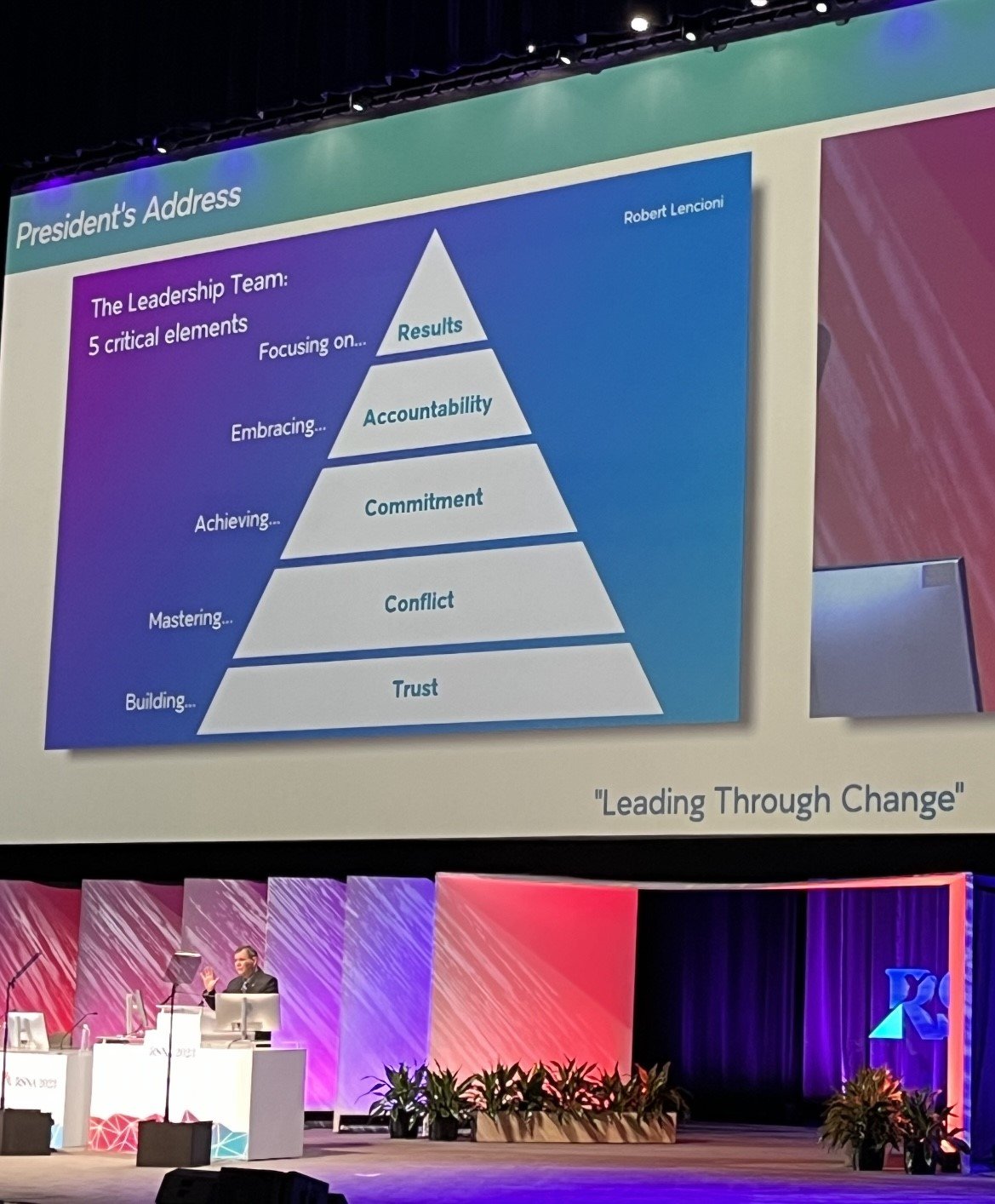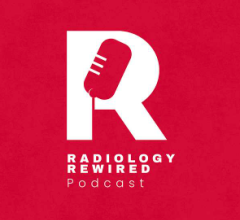
RSNA 2022-2023 President Matthew A. Mauro focused on the theme of the 109th Scientific Sessions and Annual Meeting of the Radiological Society of North America, RSNA 2023, “Leading Through Change” in his Presidential Address during the Opening Session on Sunday, Nov. 26 in the Arie Crown Theatre at McCormick Place in Chicago, IL.
November 27, 2023 — The President’s Address during the RSNA 2023 Opening Session at Sunday's first Plenary program offered an impressive range of action-oriented and motivational insights into change management from the RSNA 2022-2023 President Matthew A. Mauro, MD, FACR, FSIR, FAHA. He is the Wood Distinguished Professor of Radiology and Surgery at University of North Carolina (UNC) School of Medicine and UNC Medical Center, and serves as President, UNC Faculty Physicians. Mauro was followed by Plenary Session Lecturer Howard B. Chrisman, MD, who recently took the helm as President and CEO of Northwestern Memorial HealthCare in Chicago. To a fully-packed Arie Crown Theatre crowd, each addressed key pivot points that are coalescing to bring the practice of radiology to the fore of healthcare in ways that challenge those in it to get comfortable with change, embrace the challenges it brings and work to deliver on the promise and potential that adapting to industry changes like AI can.
What follows are a significant portions of Mauro’s comments in his address, with quotable quotes offered as he addressed the theme of RSNA 2023: Leading through Change as he called the 109th Scientific Sessions and Annual Meeting to order.
“The RSNA Annual Meeting is a time to come together to learn, share experiences and celebrate the radiology community,” noted Mauro, who, in the spirit of celebration, he acknowledged the recipients of the RSNA Gold Medals, Honorary Membership presentations, and the Outstanding Educator and Outstanding Researcher, all of whom will be recognized in a private session on Tuesday, Nov. 27, day two of RSNA.
Insight into the concept and challenge of change:
“Today, I’d like to talk about change: the necessity of it, the uncertainty of it, and ultimately. the way through it. Change will always be present and this is particularly true in the field of medicine…over the past three years, we have all faced extraordinary challenges in the face of a global pandemic that pushed medical professionals, hospitals and practices to new limits. It has been taxing, no doubt, but we have emerged on the other side wiser, nimbler and secure in the knowledge that radiology will continue to thrive if it continues to evolve.
Change is essential. It is the driver of growth. All of the great advances in our field, and in life, have emerged as a result of extraordinary pursuits of science and imagination. The manner in which we embrace and adapt to that change will ultimately determine our success in the future. As leaders, and everyone in this room leads in some capacity, success in managing change requires us to be cognizant, intentional and proactive in leading our teams, departments and organizations through significant changes to our specialty or work environment.”
Mauro shared several change management frameworks he felt would be useful for attendees. He noted, “They will help bring clarity and intentionality to your decisions, and elevate your behavior, perception and relationships with others," he offered, adding: "For many of us, medicine satisfies a calling, a desire to help others, but in today’s world, medicine is also a business…as physicians, we are in the business of helping people, and our business is impacted by the same rules and forces that affect other businesses. When facing change, it’s important to assess our environment, and to identify what forces are affecting our business.” He referenced the Six Forces Model by world renowned academic and business strategist Michael Porter. He outlined these to the audience and focused on navigating the challenges ahead for radiologists.
“Practices that can adapt and embrace such major impacts will become stronger and find themselves with a competitive advantage. Those that cannot will falter and be disadvantaged. Think of the last time a major force impacted your practice. Were you prepared? How did you adapt? Did you struggle or did you flourish? Are you stronger as a result?”
“Innovation is the cornerstone of both diagnostic and interventional radiology. With innovation as the cornerstone of radiology, we are well-positioned to accept the necessity of change to continue to advance our profession.”
He asked the following instrospective questions to the audience: "How do you know when your practice has reached its inflection point? Is your key competitor about to change? Are you willing to do whatever it takes to stay ahead of the competition? Are your key people struggling? There is little doubt our major competitors have indeed changed and will continue to change…I see more competitors on the horizon, as image guided minimally invasive care becomes more important in the management of disease processes."
Focusing on competition, workforce challenges and adaptation:
“As the competition grows in all of our subspecialties, we must ask ourselves if we are willing to step up our efforts and do whatever is necessary to protect our areas of expertise. If the answer is yes, we have reached our strategic inflection point. How our key people holding up? Are they overburdened, frustrated, losing motivation? More and more, as case volume expands amid looming radiology shortages, we are seeing burnout, dissatisfaction and zero work-life balance. Add to that the infiltration of outside competitors and the stress becomes increasingly difficult to manage. This is certainly not a sustainable model. Chairs, chiefs and group presidents are often the last to know when a high degree of frustration exists in practice. We need to do a better job of listening to our people on the front line. We need to hear from and pay attention to RSNA members and other radiology professionals in both the private and academic sectors who are the eyes and ears of our profession."
Mauro continued, "We are in a competitive world, and we must demonstrate our value in order to be successful. To demonstrate value, we must continue to adapt and evolve. Change can and will be difficult. Leading through a strategic inflection point will cause confusion and uncertainty for a period of time. But if we are committed and have a clear vision, we will come out on the other side better for having taken the journey, with new inspiration and a refreshed outlook on our specialty and practice.”
The Human Element:
“We cannot talk about leading through change without talking about the human element. How can we intentionally and proactively lead people and organizations through change? It all begins with the leadership team. Moving through change requires more than just one leader, it requires the focused effort of a highly-functional team.” Mauro referenced the work of Robert Lencioni who developed Five Critical Elements: Trust, Conflict, Committment, Accountability, Results. He noted: "It begins with building trust. When trust is present, teams can engage in constructive, idealogic conflict, otherwise there is only artificial harmony. Trust and conflict are needed to achieve commitment. Engaging in conflict enables team members to commit to a decision. People need to weigh in in order to buy in.”
Focusing on results is one of the main behaviors emphasized by Lencioni. Mauro added, “The collective results of the entire team must supersede any departmental or personal objective. Status and ego cannot get in the way of success. As we navigate through change, we need to remember that transformation is a process, not a single event. It may take years to fulfill the original vision, and shortcuts rarely work. To be successful, we need to plan, be patient and have perseverance.”
In speaking to the need for change management, Mauro also noted the work of John Kotter who drafted a roadmap to successful transformation which included the following components: Identify urgency. Create a clear vision. Communicate the vision. Empower others. Create short term wins. Institutionalize new approaches.
Speaking to coalition-building and embracing change:
“A critical component of our success is the adoption of new technologies. Through collective leadership and community, we must accelerate the acceptance of technological advancements, and advocate for their early adoption into mainstream medicine. Professional societies like the RSNA, and the resources, education and networking opportunities they offer, are vastly helpful in reading the landscape, understanding the competitive marketplace, engaging with new technologies, and building a coalition of thought leaders to empower others and enact meaningful change.”
“Our radiology networks are strong, and provide us the opportunity to solve large problems together, and to support each other through periods of transition. The prospect of change can be daunting, but when managed successfully, it can be rejuvenating. There is no doubt the future of imaging and image-guided interventions, and what we can do for our patients, is bright. Our imaging techniques are powerful and becoming more powerful with every advance. There is a clear migration to minimally invasive therapies, and with each advancement, we are able to deliver better care to our patients.”
Addressing major forces impacting radiology practices:
“As technology gains power, what does the future hold for radiologists? With the influx and rapid advancement of generative artificial intelligence, in large language models, will we still become obsolete or unnecessary? No. On the contrary, when embraced, AI will open new doors for us. As AI applications continue to improve, they will be able to absorb or assist with a host of tasks, from scheduling to reporting to triage in imaging studies, freeing the radiologists to devote more time to the more enriching aspects of our work, and the reason we chose this challenging profession. In terms of major forces that impact our business, AI is most certainly a 10X force. It is up to us to adapt and embrace it, or be left behind. So it is time to ask ourselves if we are willing to do what is necessary to navigate this 10X force.”
On adaptation to change and innovation for the future:
“To remain relevant and provide value to our patients, radiologists need to lead through this transformative moment to master the practical and ethical application of AI into the radiology workflow and practice. If change will always be present, and if change drives growth and improvement, then we need to get good at managing and leading through change. Therefore, if we constantly embrace change, rapidly adapt to innovations and technology in practice, react and respond to our inflection point, remain vigilant, and maybe even a little bit paranoid, radiology will most certainly enjoy a robust, exciting and a bright future.”
More information: www.rsna.org
Follow more of ITN's RSNA23 news conference coverage here.


 December 17, 2025
December 17, 2025 









